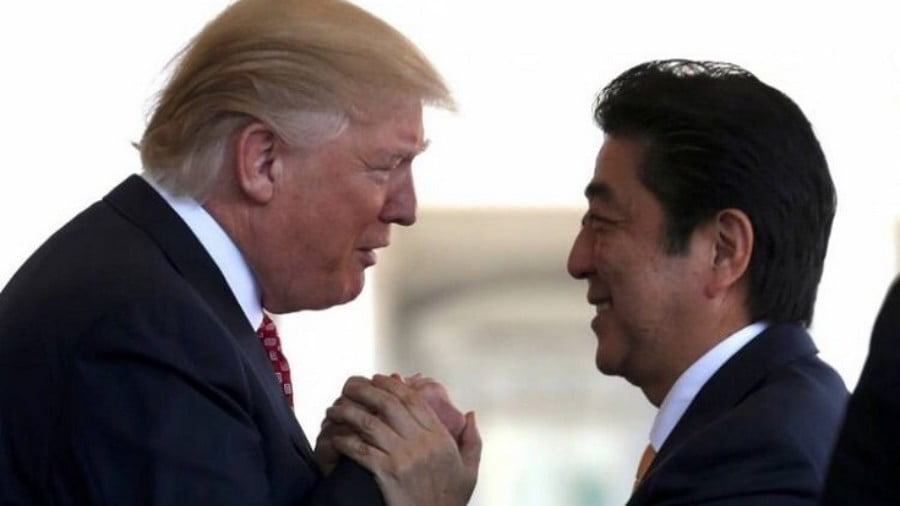Japan Aims at Taking Center Stage in Modern Geopolitics
It has been repeatedly pointed out that one of the most noteworthy trends of modern geopolitics is the return of Germany and Japan to the ranks of the world’s leading players. The two states that suffered a crushing defeat back in the days of the Second World War are now back, but have intentionally downplayed this fact across the media. The reasoning behind this approach is pretty obvious.
Any transitional period is accompanied by an abrupt increase in the level of uncertainty experienced by those undergoing it. Who would have thought in the 1920s and early 1930s that there would be no war between Britain and the US, as nobody could believe either would join forces in another against with Germany?
It’s equally pointless to try to establish what shape today’s alliances are going to take in the future, yet it’s pretty clear that all of the surviving relics of the Cold War are going to collapse, such as the military and political alliances built around it and since preserved for decades.
As for the region of the Indian and Pacific Oceans (RITO), Japan’s taking of the forefront in all manners without exception is becoming an undeniable fact, and the string of events we’ve witnessed so far in the year 2018 illustrates this notion perfectly well.
First of all, all of Japan’s economic indicators are on the rise, a trend that manifests itself in Japan’s place as the world’s third-largest economy. Moreover, it has become the principal tool of promoting Japan’s national interests in the post-WWII world. The strengthening of the positive balance in foreign trade in 2017, which is of exceptional importance for such a “trade oriented” state as Japan, has only made this trend stronger. Judging by the speech made by Prime Minister Shinzo Abe at the end of last year, in which he summed up the results of his five-year stay in office, the government he leads will continue to pay special attention to the strengthening of this principal geopolitical tool.
Its powerful economy allows Japan to occupy leading positions in global games around various international integration projects, along with voicing its obvious dissatisfaction with the protectionist tendencies in the economic policy of the new US administration.
In this respect, the summit of the 11 member countries of the Trans-Pacific Partnership (TPP), which took place on January 23 in Tokyo was pretty indicative of this. The principal decision of this summit was the setting the exact date for the next summit, launching the TPP into action with certain amendments. This act bears extreme significance both for the political and economic situation both in the Southwestern Asia region and the world in general.
It should be noted that during the previous summit in Da Nang held last November, the TPP project received a new official name – Comprehensive Progressive Trans-Pacific Partnership (CPTPP). However, to this day journalists still prefer to describe it as the TPP, only without the United States.
Both of these terms reflect the fundamental change in the new situation around the emerging economic force that was triggered by US President Donald Trump’s decision to withdraw from it made almost immediately after his inauguration. Before that, Washington was the largest player in the future TPP deal and the most active promoter of this project.
It seems that there’s certain symbolism in the decision to host this latest summit in Tokyo since Japan has been the main driving force behind the revival of the deal as the CPTPP. It seems that all of the states taking part in this project can cheer: “The promoter has died, long live the new promoter.”
Indeed, Shinzo Abe has managed to do the impossible – to revive a patient that was in deep coma for almost six months straight. The creation of the actual working CPTPP will be a major event not only in the global economy, but also in global politics.
It’s enough to quote the comment made by the Mainichi Shimbun newspaper on the outcome of the Tokyo summit which noted that its participants have “come united in their desire to overcome the pressure of the Trump administration and its trade policies.” If such an assessment is correct, and it seems that’s the case, then we are witnessing the beginning of tectonic shifts in the region.
It’s curious that the “TTP without the US” encompasses such American allies as Canada, Australia, New Zealand, as well as the US partner in the North American Free Trade Agreement (NAFTA) Mexico. In the Asian-Pacific region we’re witnessing a situation similar to the events in the Euro-Atlantic, where the refusal of the new American administration to advance integration projects with the Europeans was seen as undermining the very existence of alliances like NATO.
Regarding Canada, Mexico and NAFTA, it’s noteworthy that Canadian Prime Minister Justin Trudeau, who was also present at the Da Nang summit, in the very last minute refused to sign the already agreed papers on the creation of the CPTPP, explaining this step with the need for additional assessments of the benefits that Canada could get from this project. But the main reasoning behind this act of Canadian “sabotage” in Da Nang is due to the fact that Ottawa is now in a state of complicated negotiations with Washington over NAFTA. Therefore, Canada cannot act without keeping an eye on Washington. However, Japan seems fully aware of those concerns, as it’s been holding bilateral meeting with both of NAFTA’s member states – Canada and Mexico in a bid to clarify their standing.
After Tokyo’s efforts, by January 23 the draft of the CPTPP founding agreement was fully agreed on and is going to be signed by all the parties involved in March at a summit in Chile.
It’s curious that Australia’s Prime Minister Malcmolm Turnbull has recently visited Japan to clarify his standing on a number of issues. Judging by the final joint statement made with Shinzo Abe at the end of his visit, both Japan and Australia are firm in their desire to strengthen the bilateral “Special Strategic Partnership”, while paying special attention to raising the level of cooperation in the field of defense and security. They have also mentioned the “fundamental importance” of their economic and political ties with the United States, Japan and Australia, but those it would seem to have been made just for show.
Finally, the appearance in the Japanese press of information about the fact that Shinzo Abe will still go South Korea for the opening of the Winter Olympics which would be followed by a meeting with the South Korean president also deserves special attention. Although a month ago the media was convinced that such a development was impossible, perhaps this changed as a new situation appeared to be emerging in the region after the resumption of inter-Korean dialogue.
While attempting to assume greater regional leadership, it would be counterproductive for Japan to then stay away from events unfolding on the Korean peninsula.
It is still difficult to describe the attitude of the US and China to the growing political and economic ambitions of Japan due to the above mentioned uncertainty that accompanies any transitional state. But this by no means should be taken as the absence of any need to evaluate those attitudes.
By Vladimir Terekhov
Source: New Eastern Outlook







